Discover the 2 Types of Rattlesnakes in Wyoming
#mobileSnakeQuizControls { overflow: hidden; text-overflow: ellipsis; white-space: nowrap; }
@media (min-width: 481px) {
.mobile-top-content {
display: none;
}
}
#mobileTopContentCTACarouselControls { overflow: hidden; text-overflow: ellipsis; white-space: nowrap; }
.mobile-top-content .more { color: #fff; }
.mobile-top-content a { color: #fff; text-decoration: underline; }
.mobile-top-content a:hover { color: #fff; text-decoration: underline; }
@media (max-width: 480px) {
.mobile-top-content {
background-color: #06a10b;
color: #fff;
text-align: center;
/*height: 60px;
padding-top:5px;*/
font-size:80%;
/* display: block; */
margin: 0px -30px;
}
}
Key Points:
- The prairie rattlesnake is the only venomous snake residing in Yellowstone National Park. It’s venom is deadly, a mixture of hemotoxins and neurotoxins.
- Midget faded rattlesnakes, which only grow to about 25 inches in length, have an extremely toxic neurotoxic-myotoxic venom. Studies suggest that their venom is as toxic as a cobra’s is.
- There are 12 other varieties of snakes that reside in Wyoming, all non-venomous. Some include garter snakes, rubber boas, racer snakes, hognose snakes and whipsnakes.
Wyoming is home to at least 14 different species of snakes. However, of all the snakes in Wyoming, only two types are considered dangerous: the prairie rattlesnake and the midget faded rattlesnake. Let’s take a closer look at the two types of rattlesnakes in Wyoming.
1. Prairie Rattlesnake
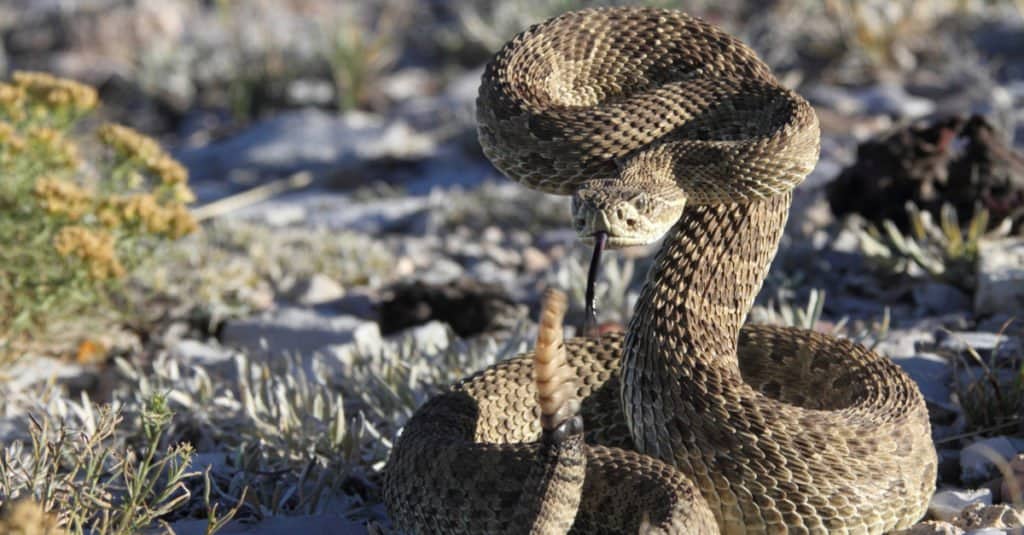
Harris Motion Photo/Shutterstock.com
| Prairie Rattlesnake | |
|---|---|
| Range | All of Wyoming, but most common in northwest Wyoming |
| Length | 34-45 inches |
The Prairie Rattlesnake lives throughout most of Wyoming but is most common in the northwestern portions of the state. In fact, it is the only venomous snake found in Yellowstone National Park, usually in the lower regions of the park.
button.pulse {
transform: scale(1); animation: pulse 2s infinite;
box-shadow: 0 0 0 0 rgba(11, 247, 25, 1);
}
@keyframes pulse {
0% { transform: scale(0.90); box-shadow: 0 0 0 0 rgba(11, 247, 25, 0.5); }
60% { transform: scale(1); box-shadow: 0 0 0 15px rgba(11, 247, 25, 0); }
100% { transform: scale(0.90); box-shadow: 0 0 0 0 rgba(11, 247, 25, 0); }
}
Prairie rattlesnakes are usually light brown, greenish brown, greenish gray, or yellow, with white-bordered dark brown blotches along their backs to help them blend in with the prairie landscape. These snakes look like they have a texture. This is because their scales are keeled with a ridge running down each scale. In Wyoming these snakes can be more than 48 inches long.
Although it looks intimidating, the prairie rattlesnake is not very aggressive. It will defend itself if provoked, but in generally it attempts to avoid humans and other large animals. There have been only two recorded cases of a prairie rattlesnake bite in Yellowstone. The venom of prairie rattlesnakes is quite potent, a mix of hemotoxins and some neurotoxins. These snakes primarily eat small mammals, but have been known to hunt small reptiles and amphibians as well.
2. Midget Faded Rattlesnake (Western Rattlesnake)
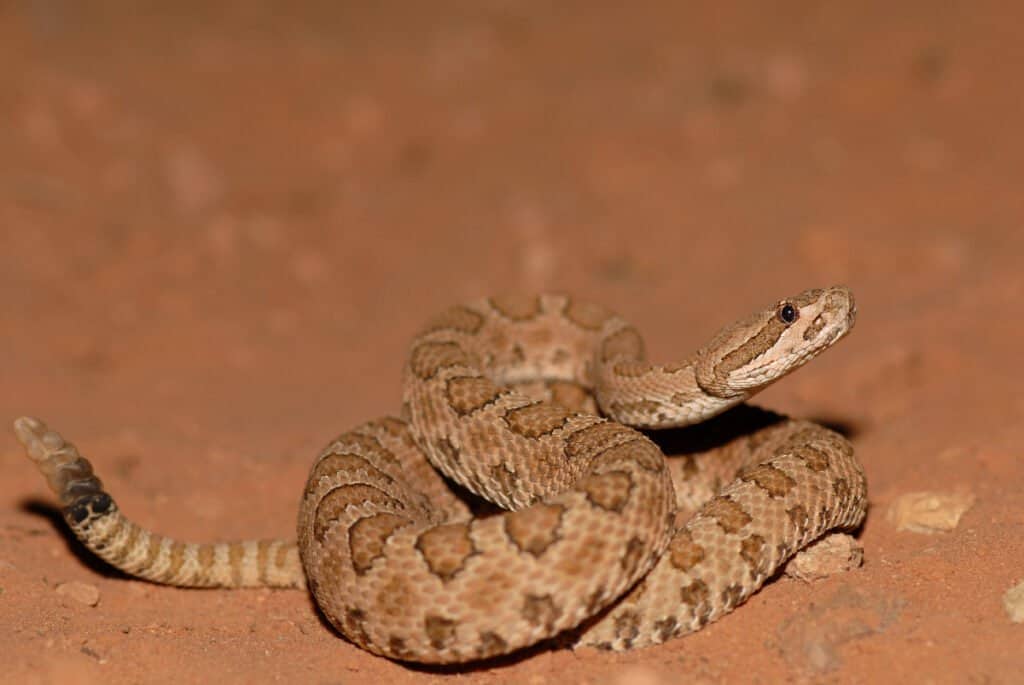
Rusty Dodson/Shutterstock.com
| Midget Faded Rattlesnake | |
|---|---|
| Range | Southern Wyoming |
| Length | 25 inches or less |
The Midget Faded Rattlesnake is a subspecies of western rattlesnake that lives in southern Wyoming in rocky areas south of the Seedskadee National Wildlife Refuge. This snake is protected by Wyoming state laws.
This is a smaller rattlesnake, growing to be no more than 25 inches long with a cream, yellow-brown, or light pinkish-brown body. Midget faded rattlesnakes have darkly outlined rectangular patterns along the length of their bodies. Younger snakes have bolder colors and more distinct patterns that fade as they get older. Older snakes can be hard to find, blending seamlessly into their rocky habitats with ease.
Midget faded rattlesnakes have an extremely toxic neurotoxic-myotoxic venom. Studies suggest that their venom is as toxic as a cobra’s is—it might even be more potent than cobra venom in some cases. Generally, these snakes eat cold-blooded animals like lizards.
Other Snakes in Wyoming
In addition to the prairie rattlesnake and the midget faded rattlesnake, there are at least 12 other kinds of non-venomous snakes that live in Wyoming. Take a look at just a few different types of Wyoming’s nonvenomous snakes.
Garter Snakes

iStock.com/Wildnerdpix
| Garter Snake | |
|---|---|
| Range | All of Wyoming |
| Length | 18-54 inches |
Garter snakes are one of the most common types of snakes living in Wyoming. There are several different types of garter snakes found in Wyoming, like the wandering garter snake, common garter snake, red-sided garter snake, and plains garter snake. Garter snakes are harmless and come in a variety of different colors, often with long vertical stripes. These snakes are very adaptable but usually live near a water source. If a garter snake feels threatened, it will usually flail its tail, try to hide its head., or release a musk. Garter snakes are excellent pest controllers, eating insects, spiders, amphibians, slugs, and leeches.
Northern Rubber Boa
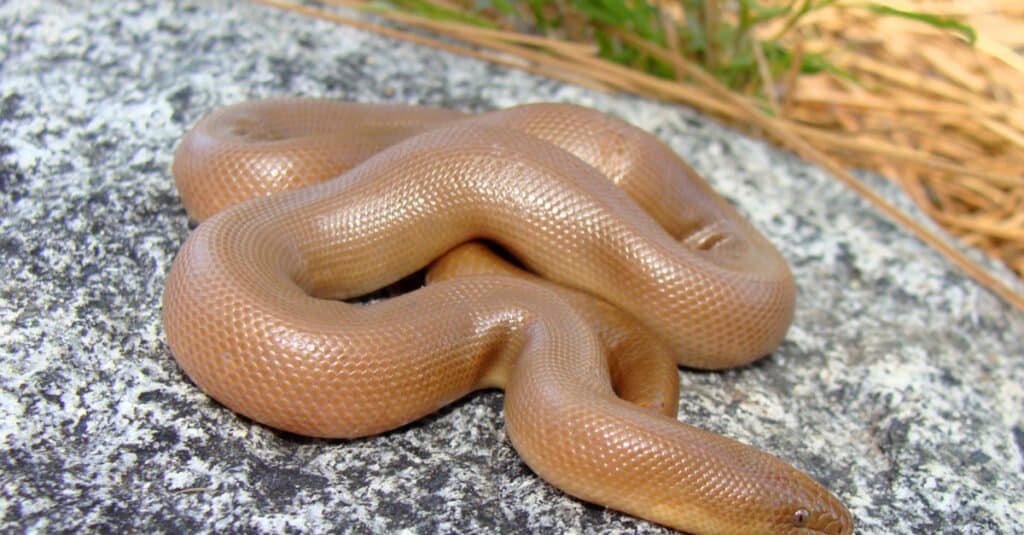
Matt Jeppson/Shutterstock.com
| Northern Rubber Boa | |
|---|---|
| Range | Northwestern corner of Wyoming |
| Length | 14-33 inches |
The Northern Rubber Boa lives in the northwestern corner of Wyoming. This snake has a rather thick body that looks like rubber, covered in tiny scales. Northern rubber boas are secretive, non-aggressive snakes, and only come out at night every few days. These snakes can climb, burrow, and swim. They eat small mammals, birds, lizards, reptile eggs, and salamanders.
North American or Eastern Racer

Matt Jeppson/Shutterstock.com
| North American or Eastern Racer | |
|---|---|
| Range | All of Wyoming |
| Length | 36-60 inches |
The North American or eastern racer is one of the most common types of snakes living in Wyoming. This snake is 36-60 inches long and is usually greenish-gray, blue, or brown in color. Its scales are very smooth, and it has a pale yellow belly. Eastern racer snakes’ eyes are quite large although their heads are relatively small. The racer is non-venomous, but it is fast and very active (which is why it is called a “racer”). In fact, its been known to reach up to 4 miles an hour in speed.
North American and Eastern racer snakes are constrictors, but they don’t typically squeeze their prey to death, opting instead to overpower and mash the prey with their coils until it succumbs or dies. They are also great tree climbers and often feast on avian prey and their eggs.
Western Hognose Snake
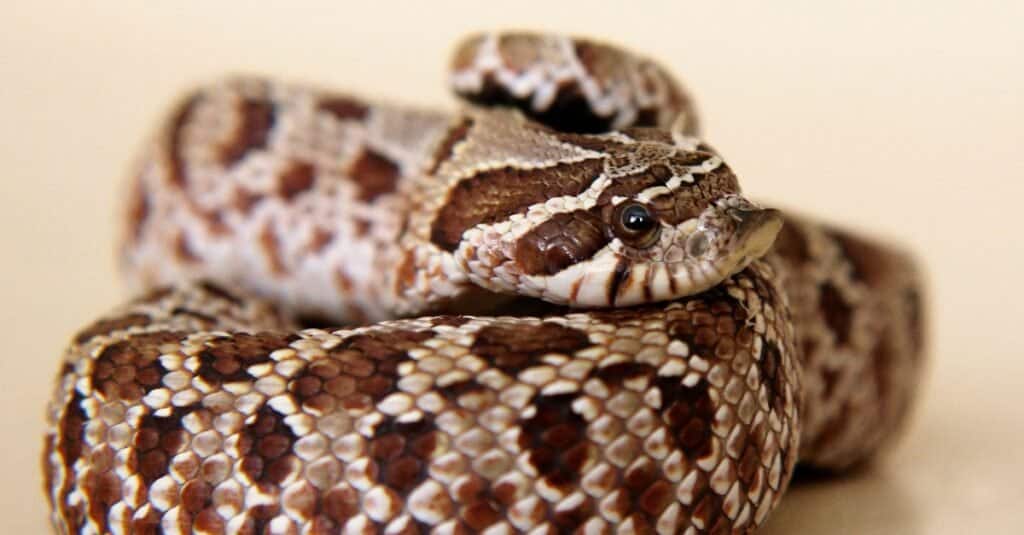
iStock.com/Iuliia Morozova
| Western Hognose Snake | |
|---|---|
| Range | Eastern Wyoming |
| Length | 15-20 inches |
The Western Hognose Snake gets its name from its hog-like nose. The snake uses this upturned snout like a small shovel to burrow in the ground. Western hognose snakes are smaller, measuring between 15-20 inches long. People often mistake these snakes for rattlesnakes when seen from a distance, but the Western hognose snake does not have venom and is not dangerous. In fact, you can find these snakes in pet stores throughout the United States. Western hognose snakes come in many different colors. Commonly they are olive green or gray-brown with darker spots along their backs.
Desert Striped Whipsnake
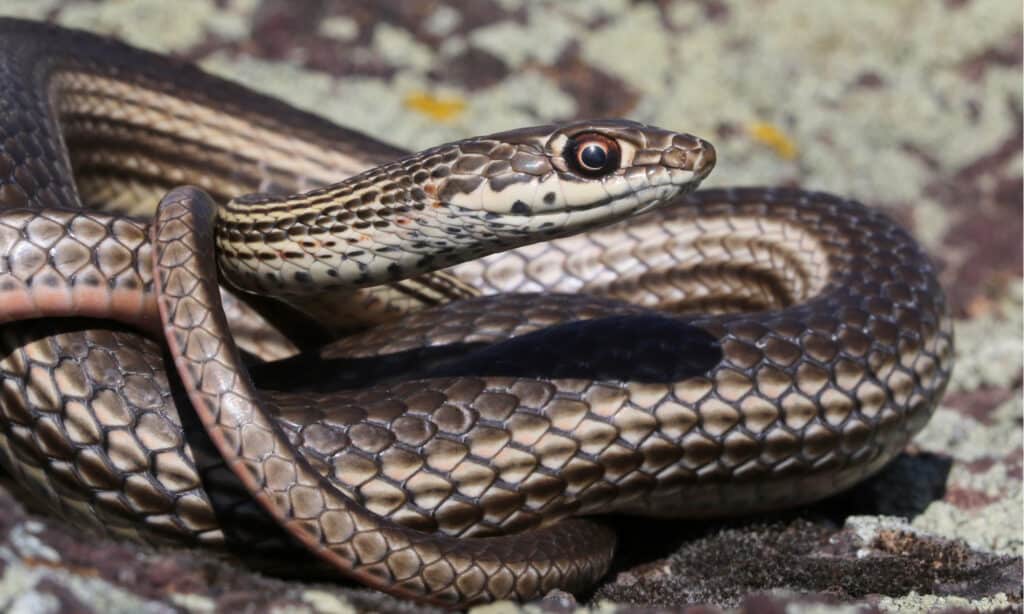
Randy Bjorklund/Shutterstock.com
| Desert Striped Whipsnake | |
|---|---|
| Range | Southwestern Wyoming |
| Length | 30-72 inches |
The Desert Striped Whipsnake lives in southwestern Wyoming near the southern part of Flaming Gorge. These snakes are 3-6 feet long with thing, whip-like bodies. Desert stiped whipsnakes are usually black, dark brown, or gray with a blue or green colored sheen. They have light stripes with intersecting black lines patterned along their bodies. Desert striped whipsnakes are savvy hunters that can quickly slip into cracks and holes and even climb trees.
Summary of 2 Rattlesnakes and Some Others in Wyoming
| Rank | Snake | Venomous |
|---|---|---|
| 1 | Prairie Rattlesnake | X |
| 2 | Midget Faded Rattlesnake | X |
| 3 | Garter Snake | |
| 4 | Northern Rubber Boa | |
| 5 | North American or Eastern Racer | |
| 6 | Western Hognose Snake | |
| 7 | Desert Striped Whipsnake |
Up Next…
- The 3 Largest Rattlesnakes in the World! What’s scarier than a rattlesnake? A really LARGE rattlesnake! Check out the 3 largest ones in the world!
- Which is More Venomous? Rattlesnake vs. King Cobra Do you think a rattlesnake is more or less venomous than a king cobra? Learn the answer to that question and more.
- Rattlesnake Population By State Let’s find out how many rattlesnakes are residing in each of our 50 states.
Discover the “Monster” Snake 5X Bigger than an Anaconda
Every day A-Z Animals sends out some of the most incredible facts in the world from our free newsletter. Want to discover the 10 most beautiful snakes in the world, a “snake island” where you’re never more than 3 feet from danger, or a “monster” snake 5X larger than an anaconda? Then sign up right now and you’ll start receiving our daily newsletter absolutely free.
More from A-Z Animals
.more-snake-card-image { max-height:140px !important; }
#mobileSnakeQuizControls { overflow: hidden; text-overflow: ellipsis; white-space: nowrap; }
@media (min-width: 481px) {
.mobile-top-content {
display: none;
}
}
#mobileTopContentCTACarouselControls { overflow: hidden; text-overflow: ellipsis; white-space: nowrap; }
.mobile-top-content .more { color: #fff; }
.mobile-top-content a { color: #fff; text-decoration: underline; }
.mobile-top-content a:hover { color: #fff; text-decoration: underline; }
@media (max-width: 480px) {
.mobile-top-content {
background-color: #06a10b;
color: #fff;
text-align: center;
/*height: 60px;
padding-top:5px;*/
font-size:80%;
/* display: block; */
margin: 0px -30px;
}
}
Key Points:
- The prairie rattlesnake is the only venomous snake residing in Yellowstone National Park. It’s venom is deadly, a mixture of hemotoxins and neurotoxins.
- Midget faded rattlesnakes, which only grow to about 25 inches in length, have an extremely toxic neurotoxic-myotoxic venom. Studies suggest that their venom is as toxic as a cobra’s is.
- There are 12 other varieties of snakes that reside in Wyoming, all non-venomous. Some include garter snakes, rubber boas, racer snakes, hognose snakes and whipsnakes.
Wyoming is home to at least 14 different species of snakes. However, of all the snakes in Wyoming, only two types are considered dangerous: the prairie rattlesnake and the midget faded rattlesnake. Let’s take a closer look at the two types of rattlesnakes in Wyoming.
1. Prairie Rattlesnake

Harris Motion Photo/Shutterstock.com
| Prairie Rattlesnake | |
|---|---|
| Range | All of Wyoming, but most common in northwest Wyoming |
| Length | 34-45 inches |
The Prairie Rattlesnake lives throughout most of Wyoming but is most common in the northwestern portions of the state. In fact, it is the only venomous snake found in Yellowstone National Park, usually in the lower regions of the park.
button.pulse {
transform: scale(1); animation: pulse 2s infinite;
box-shadow: 0 0 0 0 rgba(11, 247, 25, 1);
}
@keyframes pulse {
0% { transform: scale(0.90); box-shadow: 0 0 0 0 rgba(11, 247, 25, 0.5); }
60% { transform: scale(1); box-shadow: 0 0 0 15px rgba(11, 247, 25, 0); }
100% { transform: scale(0.90); box-shadow: 0 0 0 0 rgba(11, 247, 25, 0); }
}
Prairie rattlesnakes are usually light brown, greenish brown, greenish gray, or yellow, with white-bordered dark brown blotches along their backs to help them blend in with the prairie landscape. These snakes look like they have a texture. This is because their scales are keeled with a ridge running down each scale. In Wyoming these snakes can be more than 48 inches long.
Although it looks intimidating, the prairie rattlesnake is not very aggressive. It will defend itself if provoked, but in generally it attempts to avoid humans and other large animals. There have been only two recorded cases of a prairie rattlesnake bite in Yellowstone. The venom of prairie rattlesnakes is quite potent, a mix of hemotoxins and some neurotoxins. These snakes primarily eat small mammals, but have been known to hunt small reptiles and amphibians as well.
2. Midget Faded Rattlesnake (Western Rattlesnake)

Rusty Dodson/Shutterstock.com
| Midget Faded Rattlesnake | |
|---|---|
| Range | Southern Wyoming |
| Length | 25 inches or less |
The Midget Faded Rattlesnake is a subspecies of western rattlesnake that lives in southern Wyoming in rocky areas south of the Seedskadee National Wildlife Refuge. This snake is protected by Wyoming state laws.
This is a smaller rattlesnake, growing to be no more than 25 inches long with a cream, yellow-brown, or light pinkish-brown body. Midget faded rattlesnakes have darkly outlined rectangular patterns along the length of their bodies. Younger snakes have bolder colors and more distinct patterns that fade as they get older. Older snakes can be hard to find, blending seamlessly into their rocky habitats with ease.
Midget faded rattlesnakes have an extremely toxic neurotoxic-myotoxic venom. Studies suggest that their venom is as toxic as a cobra’s is—it might even be more potent than cobra venom in some cases. Generally, these snakes eat cold-blooded animals like lizards.
Other Snakes in Wyoming
In addition to the prairie rattlesnake and the midget faded rattlesnake, there are at least 12 other kinds of non-venomous snakes that live in Wyoming. Take a look at just a few different types of Wyoming’s nonvenomous snakes.
Garter Snakes

iStock.com/Wildnerdpix
| Garter Snake | |
|---|---|
| Range | All of Wyoming |
| Length | 18-54 inches |
Garter snakes are one of the most common types of snakes living in Wyoming. There are several different types of garter snakes found in Wyoming, like the wandering garter snake, common garter snake, red-sided garter snake, and plains garter snake. Garter snakes are harmless and come in a variety of different colors, often with long vertical stripes. These snakes are very adaptable but usually live near a water source. If a garter snake feels threatened, it will usually flail its tail, try to hide its head., or release a musk. Garter snakes are excellent pest controllers, eating insects, spiders, amphibians, slugs, and leeches.
Northern Rubber Boa

Matt Jeppson/Shutterstock.com
| Northern Rubber Boa | |
|---|---|
| Range | Northwestern corner of Wyoming |
| Length | 14-33 inches |
The Northern Rubber Boa lives in the northwestern corner of Wyoming. This snake has a rather thick body that looks like rubber, covered in tiny scales. Northern rubber boas are secretive, non-aggressive snakes, and only come out at night every few days. These snakes can climb, burrow, and swim. They eat small mammals, birds, lizards, reptile eggs, and salamanders.
North American or Eastern Racer

Matt Jeppson/Shutterstock.com
| North American or Eastern Racer | |
|---|---|
| Range | All of Wyoming |
| Length | 36-60 inches |
The North American or eastern racer is one of the most common types of snakes living in Wyoming. This snake is 36-60 inches long and is usually greenish-gray, blue, or brown in color. Its scales are very smooth, and it has a pale yellow belly. Eastern racer snakes’ eyes are quite large although their heads are relatively small. The racer is non-venomous, but it is fast and very active (which is why it is called a “racer”). In fact, its been known to reach up to 4 miles an hour in speed.
North American and Eastern racer snakes are constrictors, but they don’t typically squeeze their prey to death, opting instead to overpower and mash the prey with their coils until it succumbs or dies. They are also great tree climbers and often feast on avian prey and their eggs.
Western Hognose Snake

iStock.com/Iuliia Morozova
| Western Hognose Snake | |
|---|---|
| Range | Eastern Wyoming |
| Length | 15-20 inches |
The Western Hognose Snake gets its name from its hog-like nose. The snake uses this upturned snout like a small shovel to burrow in the ground. Western hognose snakes are smaller, measuring between 15-20 inches long. People often mistake these snakes for rattlesnakes when seen from a distance, but the Western hognose snake does not have venom and is not dangerous. In fact, you can find these snakes in pet stores throughout the United States. Western hognose snakes come in many different colors. Commonly they are olive green or gray-brown with darker spots along their backs.
Desert Striped Whipsnake

Randy Bjorklund/Shutterstock.com
| Desert Striped Whipsnake | |
|---|---|
| Range | Southwestern Wyoming |
| Length | 30-72 inches |
The Desert Striped Whipsnake lives in southwestern Wyoming near the southern part of Flaming Gorge. These snakes are 3-6 feet long with thing, whip-like bodies. Desert stiped whipsnakes are usually black, dark brown, or gray with a blue or green colored sheen. They have light stripes with intersecting black lines patterned along their bodies. Desert striped whipsnakes are savvy hunters that can quickly slip into cracks and holes and even climb trees.
Summary of 2 Rattlesnakes and Some Others in Wyoming
| Rank | Snake | Venomous |
|---|---|---|
| 1 | Prairie Rattlesnake | X |
| 2 | Midget Faded Rattlesnake | X |
| 3 | Garter Snake | |
| 4 | Northern Rubber Boa | |
| 5 | North American or Eastern Racer | |
| 6 | Western Hognose Snake | |
| 7 | Desert Striped Whipsnake |
Up Next…
- The 3 Largest Rattlesnakes in the World! What’s scarier than a rattlesnake? A really LARGE rattlesnake! Check out the 3 largest ones in the world!
- Which is More Venomous? Rattlesnake vs. King Cobra Do you think a rattlesnake is more or less venomous than a king cobra? Learn the answer to that question and more.
- Rattlesnake Population By State Let’s find out how many rattlesnakes are residing in each of our 50 states.
Discover the “Monster” Snake 5X Bigger than an Anaconda
Every day A-Z Animals sends out some of the most incredible facts in the world from our free newsletter. Want to discover the 10 most beautiful snakes in the world, a “snake island” where you’re never more than 3 feet from danger, or a “monster” snake 5X larger than an anaconda? Then sign up right now and you’ll start receiving our daily newsletter absolutely free.







